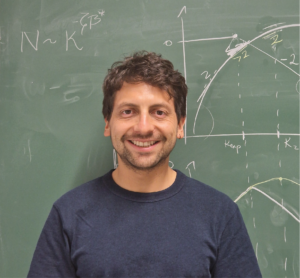Best poster prizes at ‘Theory and concepts in biology’
This past May, we were thrilled to welcome 124 on-site and 40 virtual participants to the second edition of ‘Theory and concepts in biology’. The EMBO | EMBL Symposium brought together a diverse community of researchers interested in finding ways to transform into conceptual knowledge the ever-increasing amount of factual knowledge produced by biological research.
Next to listening to groundbreaking talks, there were a lot of opportunities for networking and socialising, among them poster sessions in a lively atmosphere. Out of 66 posters, four winners were chosen to receive a best poster prize. We’re excited to introduce you to three of the winners: Roberto, Juan, and Josep!
Nonequilibrium antigen recognition during acute infections
Presenter: Roberto Morán-Tovar
Authors: Roberto Morán-Tovar, Michael Lässig

University of Cologne, Germany
Abstract:
Seventy years ago, the clonal selection theory was formulated, providing a qualitative answer to the question of how the immune system remembers past challenges. However, a quantitative formulation of the learning process is lacking. Here we postulate a minimal model of the initial immune response to an acute primary infection as a coupled process of antigen proliferation, molecular recognition by naive B cells, and their subsequent clonal expansion. This process contains a fundamental problem: the recognition of an exponentially time-dependent antigen signal. Here, we show that an efficient immune response must be stringently constrained to B-cell lineages with high antigen binding affinity. We propose a tuned molecular proofreading mechanism for primary recognition of new antigens, where the recognition machinery is adapted to the complexity of the immune repertoire. This molecular mechanism is translated to the cell population level by a novel recognition-proliferation dynamics termed “exponential proofreading”, which enables the immune system to adaptively learn about acute infections. We show that this process produces potent, specific, and fast recognition of antigens, maintaining a spectrum of genetically distinct B-cell lineages as input for affinity maturation. Our analysis maps the recognition-proliferation dynamics of a primary infection to a generalized Luria-Delbrück process, akin to the dynamics of the classic fluctuation experiment. This map establishes a link between signal recognition dynamics and evolution. We derive the resulting statistics of the activated immune repertoire: Antigen binding affinity, expected size, and frequency of active B-cell clones are related by power laws, which define the class of generalized Luria-Delbrück processes. Their exponents depend on the antigen and B-cell proliferation rate, the number of proofreading steps, and the lineage density of the naive repertoire. We extend the model to include spatiotemporal processes, including the diffusion-recognition dynamics of a vaccination. Empirical data of activated mouse immune repertoires are found to be consistent with activation involving about three proofreading steps. Our results establish infections and vaccinations as a new probe into the global architecture and functional principles of immune repertoires
Reconstructing transitions between dynamical regimes driven by unknown variables using universal normal forms
Presenter: Juan Pablo Muñoz Díaz
Authors: Juan Pablo Muñoz Díaz, Rohit Kumar, Hafeez Agboola, Narsis Aftab Kiani, David Gomez-Cabrero, Jesper Tegner

King Abdullah University of Science and Technology, Saudi Arabia
Abstract:
Decoding the nonlinear dynamical systems that model natural phenomena poses a central challenge in scientific research, where extracting governing equations is essential for forecasting, intervention, and control. This task is non-scalable due to such systems’ inherent complexity and expansive solution space. In systems biology, constructing robust dynamical models for biological processes remains a grand challenge, compounded by multiple plausible models, vast parameter spaces, and hidden variables that drive dynamics but lack observable data. These non-observables, whose identities may be unknown, make model discovery particularly difficult by influencing regime transitions without direct temporal traces. Here, we focus on deciphering nonlinear differential equations from time-series data of physical and biological systems, with dual aims: identifying the most suitable foundational elements for low-dimensional generative mathematical inference and incorporating hidden variables into robust dynamical models. We formulate a data-driven framework that leverages known normal-form structures and a polynomial assumption on bifurcation parameters to reconstruct and predict system dynamics from observed trajectories spanning diverse regimes. By employing a novel linearization technique and a robust pseudo-inverse solution, we extract minimal normal form representations that reveal hidden bifurcation control variables, bypassing the need for explicit knowledge of the underlying equations. Compared to methods like SINDy, which struggles with polynomial sensitivity and thresholding, our approach excels in capturing dynamics, especially in oscillatory regimes. Our scalable and interpretable methodology offers a powerful tool for modelling complex systems driven by unknown equations, addressing the critical role of hidden variables driving systems between different dynamical regimes.
Differential dynamical patterning during cellular growth and division
Presenter: Josep Mercadal
Authors: Josep Mercadal, Pau Formosa-Jordan

Max Planck Institute for Plant Breeding Research, Germany
Abstract:
Trichomes are specialized epidermal cells whose functions range from protecting plants from insect herbivores and UV light, increasing tolerance to freezing, to regulating plant water loss and temperature. During leaf development, trichomes emerge in periodic spatial patterns resulting from a complex network of regulatory interactions. However, understanding the key factors and mechanisms determining the spatiotemporal behavior of trichome patterns remains challenging due to the network’s inherent complexity. While simple models of trichome patterning have been proposed, their mathematical properties have not been thoroughly explored and fall short of explaining the full diversity of trichome patterns observed in nature. Here, we use mathematical modeling and spatial analysis to show that simple models of trichome patterning already contain the essential ingredients for generating diverse patterns. Specifically, we demonstrate that cell-intrinsic bistability, together with lateral inhibition mediated by a mobile factor, is sufficient to reproduce the range of patterns observed in wild-type and trichome-specific mutants, including changes in trichome density, different pattern wavelengths, and the presence of trichome clusters. By analyzing the system through bifurcation theory, we map different patterning outcomes to distinct regions of parameter space, revealing how changes in regulatory interactions shape pattern diversity. Our work provides a theoretical framework to understand the diversity of trichome patterns and their underlying mechanistic basis, highlighting how the intrinsic adaptability of the trichome network enables diverse developmental responses to changing environmental conditions.
The EMBO | EMBL Symposium ‘Theory and concepts in biology’ took place from 6 – 9 May 2025 at EMBL Heidelberg and virtually.